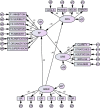Differential Predictive Effect of Self-Regulation Behavior and the Combination of Self- vs. External Regulation Behavior on Executive Dysfunctions and Emotion Regulation Difficulties, in University Students
- PMID: 35814083
- PMCID: PMC9258503
- DOI: 10.3389/fpsyg.2022.876292
Differential Predictive Effect of Self-Regulation Behavior and the Combination of Self- vs. External Regulation Behavior on Executive Dysfunctions and Emotion Regulation Difficulties, in University Students
Abstract
The aim of this research was to establish linear relations (association and prediction) and inferential relations between three constructs at different levels of psychological research - executive dysfunction (microanalysis), self-regulation (molecular level), and self- vs. external regulation (molar level), in the prediction of emotion regulation difficulties. We hypothesized that personal and contextual regulatory factors would be negatively related to levels of executive dysfunction and emotion regulation difficulties; by way of complement, non-regulatory and dysregulatory personal, and contextual factors would be positively related to these same difficulties. To establish relationships, we used a retrospective, ex post facto design, where 298 university students voluntarily participated by completing standardized self-reports. Linear and structural correlational, predictive analyses were performed, as well as inferential analyses. Results were consistent and validated the proposed hypotheses, for both association and prediction. The most important result refers to the discriminant value of the five-level combination heuristic for predicting Executive Function and External (contextual) Dys-Regulation. In conclusion: (1) both personal and contextual regulation factors must be analyzed in order to better understand the variation in executive functions and emotion regulation difficulties; (2) it is important to continue connecting the different levels of the constructs referring to self-regulation, given their complementary role in the behavioral analysis of regulation difficulties.
Keywords: emotion regulation difficulties; executive functions; self- vs. external regulation; self-regulation; university students.
Copyright © 2022 de la Fuente, Martínez-Vicente, Pachón-Basallo, Peralta-Sánchez, Vera-Martínez and Andrés-Romero.
Conflict of interest statement
The authors declare that the research was conducted in the absence of any commercial or financial relationships that could be construed as a potential conflict of interest.
Figures

Similar articles
-
Regulation/Non-Regulation/Dys-Regulation of Health Behavior, Psychological Reactance, and Health of University Undergraduate Students.Int J Environ Res Public Health. 2021 Apr 5;18(7):3793. doi: 10.3390/ijerph18073793. Int J Environ Res Public Health. 2021. PMID: 33916478 Free PMC article.
-
Self- vs. External-Regulation Behavior ScaleTM in different psychological contexts: A validation study.Front Psychol. 2022 Oct 26;13:922633. doi: 10.3389/fpsyg.2022.922633. eCollection 2022. Front Psychol. 2022. PMID: 36389553 Free PMC article.
-
Effects of Self-Regulation vs. External Regulation on the Factors and Symptoms of Academic Stress in Undergraduate Students.Front Psychol. 2020 Aug 26;11:1773. doi: 10.3389/fpsyg.2020.01773. eCollection 2020. Front Psychol. 2020. PMID: 32982819 Free PMC article.
-
Cognitive deficits in bipolar disorders: Implications for emotion.Clin Psychol Rev. 2018 Feb;59:126-136. doi: 10.1016/j.cpr.2017.11.006. Epub 2017 Nov 21. Clin Psychol Rev. 2018. PMID: 29195773 Free PMC article. Review.
-
Engineering Virtuous health habits using Emotion and Neurocognition: Flexibility for Lifestyle Optimization and Weight management (EVEN FLOW).Front Aging Neurosci. 2023 Nov 22;15:1256430. doi: 10.3389/fnagi.2023.1256430. eCollection 2023. Front Aging Neurosci. 2023. PMID: 38076541 Free PMC article. Review.
Cited by
-
Advances on Self-Regulation Models: A New Research Agenda Through the SR vs ER Behavior Theory in Different Psychology Contexts.Front Psychol. 2022 Jul 15;13:861493. doi: 10.3389/fpsyg.2022.861493. eCollection 2022. Front Psychol. 2022. PMID: 35910968 Free PMC article. Review.
-
Conceptual Utility Model for the Management of Stress and Psychological Wellbeing, CMMSPW™ in a university environment: theoretical basis, structure and functionality.Front Psychol. 2024 Jan 31;14:1299224. doi: 10.3389/fpsyg.2023.1299224. eCollection 2023. Front Psychol. 2024. PMID: 38356996 Free PMC article.
-
Dysexecutive symptomatology in everyday functioning and academic achievement in adolescents.Front Psychol. 2024 May 28;15:1323317. doi: 10.3389/fpsyg.2024.1323317. eCollection 2024. Front Psychol. 2024. PMID: 38863662 Free PMC article.
-
Assessing Frontal Lobe Function on Verbal Fluency and Emotion Recall in Autism Spectrum Disorder by fNIRS.J Autism Dev Disord. 2025 May;55(5):1648-1659. doi: 10.1007/s10803-024-06306-5. Epub 2024 Apr 18. J Autism Dev Disord. 2025. PMID: 38635133
-
Addressing the links between and internal vs. external regulation factors, achievement emotions and gender in problematic use of ICT at university.Front Psychol. 2024 Aug 6;15:1382016. doi: 10.3389/fpsyg.2024.1382016. eCollection 2024. Front Psychol. 2024. PMID: 39165764 Free PMC article.
References
-
- Ahmed S., Tang S., Waters N. E., Davis-Kean P. (2019). Executive function and academic achievement: longitudinal relations from early childhood to adolescence. J. Educ. Psychol. 111 446–458. 10.1037/edu0000296 - DOI
-
- Arbuckle J. L. (2014). Amos (Version 23.0). Chicago, IL: IBM SPSS.
-
- Ato M., López J., Benavente A. (2013). Un sistema de clasificación de los diseños de investigación [a classification system for research designs]. An. Psicología 29 1038–1059. 10.6018/analesps.29.3.178511 - DOI
LinkOut - more resources
Full Text Sources

